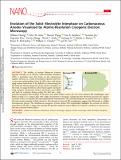| dc.contributor.author | Huang, William | |
| dc.contributor.author | Attia, Peter M. | |
| dc.contributor.author | Wang, Hansen | |
| dc.contributor.author | Renfrew, Sara E. | |
| dc.contributor.author | Jin, Norman | |
| dc.contributor.author | Das, Supratim | |
| dc.contributor.author | Zhang, Zewen | |
| dc.contributor.author | Boyle, David T. | |
| dc.contributor.author | Li, Yuzhang | |
| dc.contributor.author | Bazant, Martin Z. | |
| dc.contributor.author | McCloskey, Bryan D. | |
| dc.contributor.author | Chueh, William C. | |
| dc.contributor.author | Cui, Yi | |
| dc.date.accessioned | 2022-05-31T19:30:10Z | |
| dc.date.available | 2021-10-27T20:09:14Z | |
| dc.date.available | 2022-05-31T19:30:10Z | |
| dc.date.issued | 2019-07 | |
| dc.date.submitted | 2019-07 | |
| dc.identifier.issn | 1530-6984 | |
| dc.identifier.issn | 1530-6992 | |
| dc.identifier.uri | https://hdl.handle.net/1721.1/134800.2 | |
| dc.description.abstract | © 2019 American Chemical Society. The stability of modern lithium-ion batteries depends critically on an effective solid-electrolyte interphase (SEI), a passivation layer that forms on the carbonaceous negative electrode as a result of electrolyte reduction. However, a nanoscopic understanding of how the SEI evolves with battery aging remains limited due to the difficulty in characterizing the structural and chemical properties of this sensitive interphase. In this work, we image the SEI on carbon black negative electrodes using cryogenic transmission electron microscopy (cryo-TEM) and track its evolution during cycling. We find that a thin, primarily amorphous SEI nucleates on the first cycle, which further evolves into one of two distinct SEI morphologies upon further cycling: (1) a compact SEI, with a high concentration of inorganic components that effectively passivates the negative electrode; and (2) an extended SEI spanning hundreds of nanometers. This extended SEI grows on particles that lack a compact SEI and consists primarily of alkyl carbonates. The diversity in observed SEI morphologies suggests that SEI growth is a highly heterogeneous process. The simultaneous emergence of these distinct SEI morphologies highlights the necessity of effective passivation by the SEI, as large-scale extended SEI growths negatively impact lithium-ion transport, contribute to capacity loss, and may accelerate battery failure. | en_US |
| dc.language.iso | en | |
| dc.publisher | American Chemical Society (ACS) | en_US |
| dc.relation.isversionof | http://dx.doi.org/10.1021/acs.nanolett.9b01515 | en_US |
| dc.rights | Article is made available in accordance with the publisher's policy and may be subject to US copyright law. Please refer to the publisher's site for terms of use. | en_US |
| dc.source | Other repository | en_US |
| dc.title | Evolution of the Solid–Electrolyte Interphase on Carbonaceous Anodes Visualized by Atomic-Resolution Cryogenic Electron Microscopy | en_US |
| dc.type | Article | en_US |
| dc.contributor.department | Massachusetts Institute of Technology. Department of Chemical Engineering | |
| dc.relation.journal | Nano Letters | en_US |
| dc.eprint.version | Author's final manuscript | en_US |
| dc.type.uri | http://purl.org/eprint/type/JournalArticle | en_US |
| eprint.status | http://purl.org/eprint/status/PeerReviewed | en_US |
| dc.date.updated | 2019-08-14T13:25:31Z | |
| dspace.orderedauthors | Huang, W; Attia, PM; Wang, H; Renfrew, SE; Jin, N; Das, S; Zhang, Z; Boyle, DT; Li, Y; Bazant, MZ; McCloskey, BD; Chueh, WC; Cui, Y | en_US |
| dspace.date.submission | 2019-08-14T13:25:33Z | |
| mit.journal.volume | 19 | en_US |
| mit.journal.issue | 8 | en_US |
| mit.license | PUBLISHER_POLICY | |
| mit.metadata.status | Authority Work Needed | en_US |
